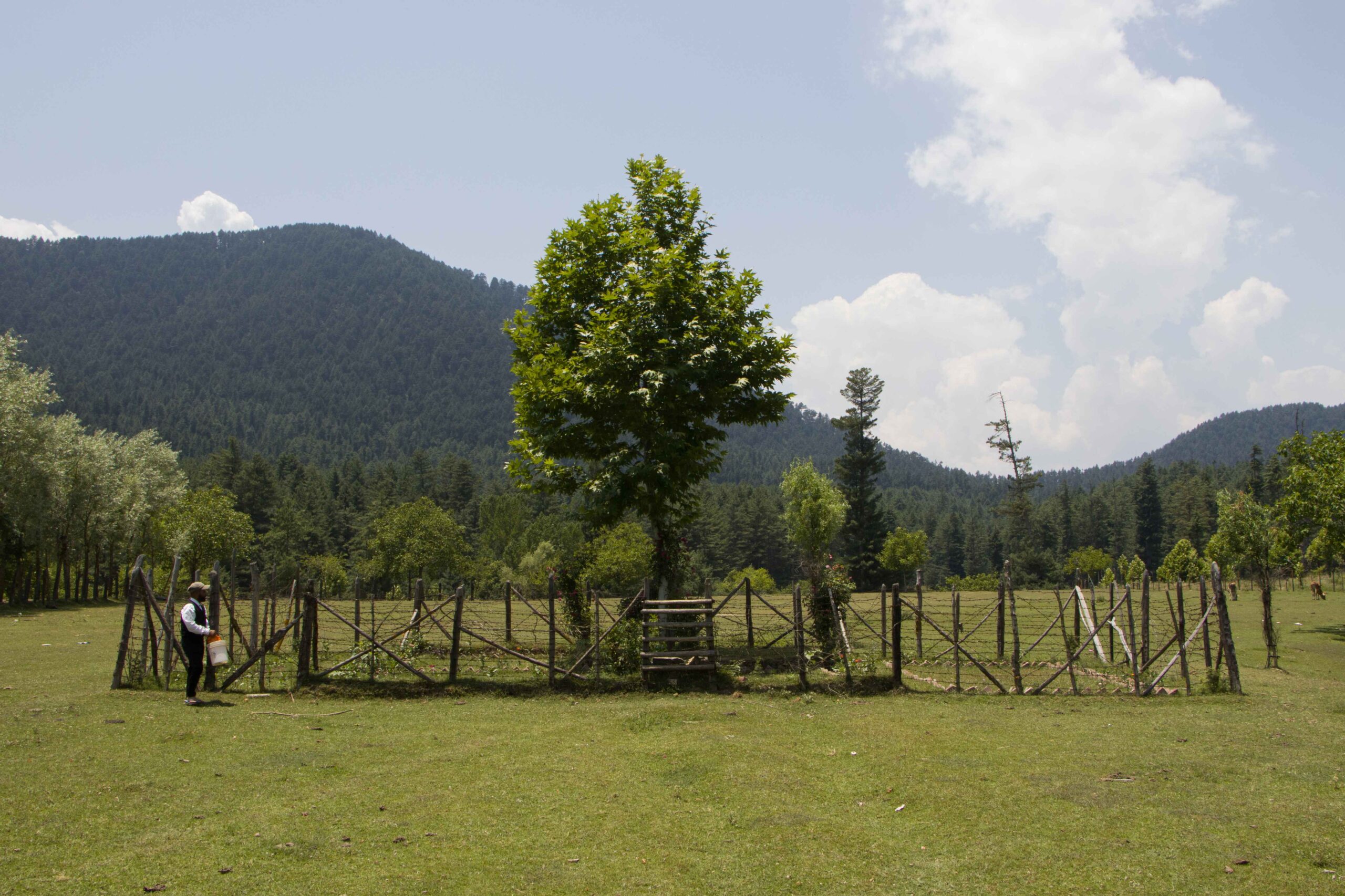
Bhat Yasir, Umar Farooq, TwoCircles.net
Srinagar: Nestled within the rugged terrain of Jammu and Kashmir’s frontier district of Kupwara lies a remote village where a man’s commitment to conserve nature is reshaping the landscape. Abdul Ahad Khan, a daily wage earner, has taken it upon himself to plant Chinar trees in an effort to restore the region’s natural beauty and biodiversity.
Belonging to a far-flung village, Nagri of Kupwara district surrounded by paddy fields and forests, Khan has been planting Chinar trees for over a decade. His noble work is turning the ‘Baand Wuder’ — the lush green mountain where Khan plants trees.

At a time when deforestation in the name of development has become a norm, Khan’s relentless effort to plant trees has earned the title of “Chinar Man”. He has been awarded the title by Forest Department officials.
Chinar, a deciduous tree of the Platanaceae family that grows to a height of 30 metres or more, is known for its longevity and spreading crown. In autumn, its deep green leaves may change to blood red, amber and yellow. Known as ‘Buen’ and ‘Booyn’ in Kashmiri language, it is the living heritage and a part of the tradition of the Valley.

38-year-old Khan says he once visited ‘Baand Wuder’ and found it open. “There wasn’t any spot where people could stay under shadow,” he said. Then he decided to plant trees there, “firstly I decided to plant walnut trees there but later I changed my plan and started planting chinar trees.”
Chinar trees, he said, maintain a clean atmosphere and offer fresh oxygen.
“The birds enjoy resting on these beautiful trees, and it pleases me to the core,” he told TwoCircles.net.
“I plant Chinar in March each year. Once it grows four to five feet after two years, I root it out and plant it at different places,” he said.
It took Khan many months to understand and experiment the process from rooting branches to growing trees.

Initially faced many challenges such as poor survival rates due to insufficient watering, he learned and adopted the best practices to ensure the successful growth of the trees.
However, it was not a single challenge that he faced. Opposition of local residents was another major hurdle in the way of his noble passion. Many times, he alleged, the locals destroyed the plants.
“But now, when Chinars have grown, they are happy and appreciate me,” he said, adding, “When I see anyone sitting under the shade of the tree, I feel very happy”.
He said he was often discouraged by his well-wishers who used to suggest to him that he should concentrate on his source of livelihood instead of planting trees, but he did not give up.
A small lake called Sar serves him as a source of water for irrigation.

His day starts with visiting Baand Wuder every morning and watering Chinar trees. This is his daily routine. Even in the winter season, when heavy snowfall makes lives difficult, he visits the mountain and cleans the trees from snow to save it from getting damaged.
Khan belongs to a humble family background and lives in an old wooden house with an aged mother and two other brothers who also work as daily wagers. Numerous challenges and financial constraints failed to shake his determination.
His mother Jannat says she feels proud as her son plants chinar trees. “We never stopped him,” she said, complaining that the fellow villagers never supported him in his selfless work.

She has a hope that the government will employ her son in any department where he can continue his work.
Khan is planting these trees on forest department’s land. He said the officials of the Forest Department never stopped him from doing so.
“On the contrary, they supported me. This year, I have provided the department over 700 Chinar tree saplings for plantation across the Valley,” he claimed.
Asked for how long will he continue doing it, he said, “I will never stop it I am alive.”
He has a piece of advice for everyone: grow tress as much as you can to make environment greener and cleaner.
Baand Wuder, according to a group of locals who were sitting under the Chinar trees planted by Khan, was an open mountain before the forestation initiative was undertaken.
“This was an open field. No one found it a resting place because of the direct sunlight,” said Jamsheed Ahmad, a local.
Dr. Suhaib Ahmad Bandh, assistant professor, environmental science, SP College, Srinagar, said, Chinar trees are culturally significant in regions like Kashmir and are celebrated for their majestic beauty and symbolic value. “Ecologically, the tree stabilises soil, provides shade and supports diverse wildlife,” he added.
Unfortunately, its population is declining as a result of mindless urbanization, deforestation and climate change-induced stressors such erratic rainfall patterns.
Bandh further said that urgent conservation measures, including habitat restoration, sustainable forestry and community involvement are essential to safeguard this iconic species and preserve its invaluable ecological, cultural and socio economic contributions for future generations.

“While the ban on cutting trees aims to protect existing forests and biodiversity, at the same time, it may indirectly hinder individuals from planting more trees on their lands if they perceive regulatory hurdles or lack incentives for tree planting,” he said. (Chinar is regarded as one of the heritage trees of Kashmir and its felling and lopping is banned under the Jammu and Kashmir Reservation of Specified Trees Act, 1969. That’s why he says indirectly it hinders people from planting chinar trees because people think they won’t be allowed to cut it tomorrow if required.)
Research by Sheikh Tajamul Islam, Masood Majaz Ganaie, Vinit Kumar and Sami Ullah Bhat on Chinar trees in Pulwama district highlights that Humans have always been ignorant about the benefits of nature.
Owing to turmoil and increase in habitational areas, population growth and building constructions, a significant decline Chinar cover has been noted.
The dwindling numbers of the tree poses a threat to the heritage of the Valley and illustrates the ignorance and apathy towards harmonic coexistence with nature.
“The present study seems that the plantation of the chinar tree has remained a conscious and deliberate social cause as otherwise the tree has no such a big economic importance, neither its wood has remained any product of demand,” said the study, suggesting, “A ‘Chipkoo’ type movement should be launched to spread the awareness about the importance of Chinar”.
The tree, according to the researcher, has been used for doing meditation over several years and is considered sacred. And hence it is planted around places of worship.
Other than religious importance, chinar is a good ornamental tree. Its leaves are used as charcoal, the wood in crafts and the huge branches house birds like the kite (Milvus migrans).
The decoction of boiled bark of Chinar is used in Greek folk medicine to treat haemorrhage and relieve burns. When it is mixed with potassium carbonate, the compound is used as a traditional dye for silk.
Chinar has also an impact on Kashmiri arts and crafts. Weavers Chinar leaf patterns on shawls.

